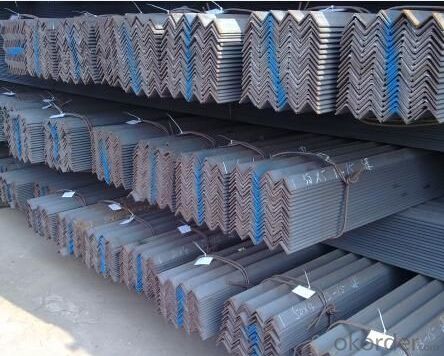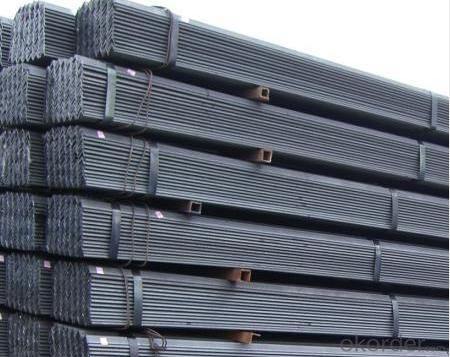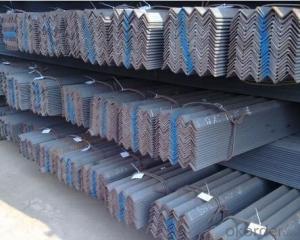Stainless Angle Steel with Standards GB,ASTM,BS,AISI,DIN,JIS
- Loading Port:
- Tianjin
- Payment Terms:
- TT or LC
- Min Order Qty:
- 20 m.t.
- Supply Capability:
- 100 m.t./month
OKorder Service Pledge
OKorder Financial Service
You Might Also Like
Product Description:
OKorder is offering Stainless Angle Steel with Standards GB,ASTM,BS,AISI,DIN,JIS at great prices with worldwide shipping. Our supplier is a world-class manufacturer of steel, with our products utilized the world over. OKorder annually supplies products to European, North American and Asian markets. We provide quotations within 24 hours of receiving an inquiry and guarantee competitive prices.
Product Applications:
Stainless Angle Steel with Standards GB,ASTM,BS,AISI,DIN,JIS are ideal for structural applications and are widely used in the construction of buildings and bridges, and the manufacturing, petrochemical, and transportation industries.
Product Advantages:
OKorder's Stainless Angle Steel with Standards GB,ASTM,BS,AISI,DIN,JIS are durable, strong, and resist corrosion.
Main Product Features:
· Premium quality
· Prompt delivery & seaworthy packing (30 days after receiving deposit)
· Corrosion resistance
· Can be recycled and reused
· Mill test certification
· Professional Service
· Competitive pricing
Product Specifications:
1.Standards:GB,ASTM,BS,AISI,DIN,JIS
2.Invoicing on theoretical weight or actual weight as customer request
3.Material: JIS G3192,SS400;SS540.
4. Payment terms:
1).100% irrevocable L/C at sight.
2).30% T/T prepaid and the balance against the copy of B/L.
3).30% T/T prepaid and the balance against L/C
5.Sizes
EQUAL ANGLES SIZES |
| ||
a(mm) | a1(mm) | thickness(mm) | length |
25 | 25 | 2.5---3.0 | 6M/12M |
30 | 30 | 2.5---4.0 | 6M/12M |
38 | 38 | 2.5 | 6M/12M |
38 | 38 | 3.0---5.0 | 6M/12M |
40 | 40 | 3.0---6.0 | 6M/12M |
50 | 50 | 3 | 6M/12M |
50 | 50 | 3.7---6.0 | 6M/9M/12M |
60 | 60 | 5.0---6.0 | 6M/9M/12M |
63 | 63 | 6.0---8.0 | 6M/9M/12M |
65 | 65 | 5.0---8.0 | 6M/9M/12M |
70 | 70 | 6.0---7.0 | 6M/9M/12M |
75 | 75 | 5.0---10.0 | 6M/9M/12M |
80 | 80 | 6.0---10.0 | 6M/9M/12M |
90 | 90 | 6.0---10.0 | 6M/9M/12M |
100 | 100 | 6.0---12.0 | 6M/9M/12M |
120 | 120 | 8.0-12.0 | 6M/9M/12M |
125 | 125 | 8.0---12.0 | 6M/9M/12M |
130 | 130 | 9.0-12.0 | 6M/9M/12M |
140 | 140 | 10.0-16.0 | 6M/9M/12M |
150 | 150 | 10---15 | 6M/9M/12M |
160 | 160 | 10---16 | 6M/9M/12M |
180 | 180 | 12---18 | 6M/9M/12M |
200 | 200 | 14---20 | 6M/9M/12M |
5. Material Specifications:
Grade | Yield Strength,N/mm² | Extension Strength N/mm² | |||
Thickness of Steel,mm | |||||
≦16 | >16-≦40 | >40-≦100 | >100 | ||
SS330 | ≧205 | ≧195 | ≧175 | ≧165 | 330-430 |
SS400 | ≧245 | ≧235 | ≧215 | ≧205 | 400-510 |
SS490 | ≧285 | ≧275 | ≧255 | ≧245 | 490-610 |
SS540 | ≧400 | ≧390 | - | - | ≧540 |
Usage & Applications JIS SS400 Angle Steel
Trusses;
Transmission towers;
Telecommunication towers;
Bracing for general structures;
Stiffeners in structural use.
Packaging & Delivery of JIS SS400 Angle Steel
1. Transportation: the goods are delivered by truck from mill to loading port, the maximum quantity can be loaded is around 40MTs by each truck. If the order quantity cannot reach the full truck loaded, the transportation cost per ton will be little higher than full load.
2. With bundles and load in 20 feet/40 feet container, or by bulk cargo, also we could do as customer's request.
3. Marks:
Color mark: There will be color marking on both end of the bundle for the cargo delivered by bulk vessel. That makes it easily to distinguish at the destination port.
Tag mark: There will be tag mark tied up on the bundles. The information usually including supplier logo and name, product name, made in China, shipping marks and other information request by the customer.
If loading by container the marking is not needed, but we will prepare it as customer request.
Production flow of JIS SS400 Angle Steel
Material prepare (billet) —heat up—rough rolling—precision rolling—cooling—packing—storage and transportation
FAQ:
Q1: Why buy Materials & Equipment from OKorder.com?
A1: All products offered byOKorder.com are carefully selected from China's most reliable manufacturing enterprises. Through its ISO certifications, OKorder.com adheres to the highest standards and a commitment to supply chain safety and customer satisfaction.
Q2: How do we guarantee the quality of our products?
A2: We have established an advanced quality management system which conducts strict quality tests at every step, from raw materials to the final product. At the same time, we provide extensive follow-up service assurances as required.
Q3: How soon can we receive the product after purchase?
A3: Within three days of placing an order, we will begin production. The specific shipping date is dependent upon international and government factors, but is typically 7 to 10 workdays.


- Q:Can steel angles be used for architectural purposes?
- Yes, steel angles can certainly be used for architectural purposes. Steel angles are versatile structural components that can be used in various architectural applications. They are often used to provide structural support and stability in building construction. Steel angles can be used as lintels or beams to support the weight of walls, roofs, or floors. They can also be used as columns or braces to reinforce the structural integrity of a building. Additionally, steel angles can be used as decorative elements in architectural designs, adding a modern and industrial aesthetic to the overall look of a structure. Their durability, strength, and malleability make steel angles a popular choice for architects and engineers when designing and constructing buildings.
- Q:How do you specify steel angles in drawings?
- In order to specify steel angles in drawings, several key parameters need to be specified. Firstly, the angle size needs to be clearly indicated, usually by providing the leg lengths or the dimensions of the equal sides. For example, a 3" x 3" x 1/4" angle would have legs measuring 3 inches each and a thickness of 1/4 inch. Next, the type of angle needs to be indicated, such as L-shaped or unequal angles. This information is important as it helps determine the appropriate steel angle to be used for a specific application. Additionally, the material grade of the steel angle should be specified. Steel angles are available in various grades, which determine the strength and durability of the angle. Common grades include A36, A572, and A588, among others. The grade is typically specified to ensure the angle meets the required structural or mechanical properties. The length of the steel angle is another important parameter that needs to be stated in the drawing. Whether it is a fixed length or a specific range, this information enables accurate fabrication and installation. Finally, any additional requirements or specifications, such as surface finish, tolerance, or any specific treatments or coatings, should also be clearly indicated in the drawing to ensure the steel angle is manufactured and installed according to the desired specifications. By providing these parameters in the drawings, engineers, fabricators, and contractors can easily identify and accurately procure the required steel angles for construction or manufacturing purposes.
- Q:What is the difference between hot-rolled and cold-formed steel angles?
- Hot-rolled steel angles and cold-formed steel angles find use in various construction and industrial applications, but they differ in how they are made and the characteristics they possess. To produce hot-rolled steel angles, a steel billet or slab is heated above its recrystallization temperature and then passed through rollers to shape it as desired. This process allows for the creation of bends, curves, and other intricate angles. Hot rolling also leads to a rougher surface finish and slightly rounded edges, which can be advantageous in certain applications. Furthermore, hot-rolled steel angles are available in a wider range of sizes and thicknesses. On the other hand, cold-formed steel angles are formed by bending a flat strip of steel at room temperature using dies and rolls. This process does not involve heating the steel, preserving its existing physical properties. Consequently, cold-formed steel angles have a smoother surface finish and sharper, more defined edges compared to hot-rolled angles. The cold-forming process also enables tighter tolerances and more precise dimensions. Regarding mechanical properties, hot-rolled steel angles generally exhibit higher tensile strength and yield strength than cold-formed angles. This can be attributed to the heat treatment involved in hot rolling, which refines the grain structure and enhances the overall strength of the steel. Cold-formed steel angles, while typically less strong, are often preferred when weight reduction is a priority, as they are generally lighter than their hot-rolled counterparts. In conclusion, the main distinctions between hot-rolled and cold-formed steel angles lie in their manufacturing processes, resulting surface finishes, dimensional precision, and mechanical properties. The choice between the two depends on the specific requirements and limitations of the given project.
- Q:How are steel angles installed or fixed in place?
- Steel angles can be installed or fixed in place using various methods such as welding, bolting, or using adhesive agents. Welding involves melting the steel angle and the surface it is being fixed to, and then fusing them together. Bolting involves using bolts and nuts to secure the steel angle to the desired surface. Adhesive agents can also be used to bond the steel angle to the surface. The specific method chosen depends on the requirements of the installation and the strength and stability needed.
- Q:Are steel angles available in different grades of steel?
- Different grades of steel are available for steel angles, which are widely used in the construction and manufacturing industries for various purposes including structural support, framing, and bracing. The grade of steel used in steel angles is determined based on its chemical composition, mechanical properties, and intended use. A36, A572, and A588 are some common grades of steel used for steel angles, each with specific characteristics suited for different applications. For instance, A36 steel angles are commonly utilized for general structural purposes, whereas A572 steel angles possess higher strength and are often utilized in heavy-duty construction projects. The selection of the grade depends on factors like load-bearing capacity, corrosion resistance, and cost considerations.
- Q:How do you protect steel angles from chemical exposure?
- To protect steel angles from chemical exposure, various methods can be employed. One effective approach is to apply a protective coating such as enamel or epoxy paint, which acts as a barrier against corrosive chemicals. Additionally, using corrosion-resistant materials such as stainless steel angles or galvanized coatings can enhance their resistance to chemical exposure. Proper storage and handling practices, ensuring minimal contact with corrosive substances, can also contribute to protecting steel angles from chemical damage.
- Q:What are the different types of steel angles connections for joists?
- Joists commonly employ several types of steel angle connections. These options include: 1. Welded Connection: The simplest and most prevalent connection involves directly welding the steel angles to the joists. This method provides a sturdy and inflexible connection, albeit requiring skilled labor and additional welding time. 2. Bolted Connection: This connection involves fastening the steel angles to the joists using bolts or screws. It allows for easier installation and disassembly if necessary. However, it may not be as robust as a welded connection and may necessitate periodic bolt tightening. 3. Gusset Plate Connection: A flat steel plate known as a gusset plate connects the steel angles to the joists. Typically, this plate is secured by welding or bolting to both the angles and the joists, enhancing the connection's strength and stability. 4. Clip Angle Connection: L-shaped brackets called clip angles attach to the joists and steel angles using bolts or screws. This method offers a straightforward and efficient means of connecting angles to the joists, with the added benefit of easy adjustment or replacement. 5. Shear Plate Connection: This connection type employs a thick steel plate with holes, known as a shear plate, to link the steel angles to the joists. Like the gusset plate connection, the shear plate is usually welded or bolted to both the angles and the joists, ensuring a robust and secure connection. The selection of a particular steel angle connection method depends on factors such as load requirements, installation ease, and cost considerations, as each option presents its own advantages and disadvantages.
- Q:Are steel angles available in different grades?
- Yes, steel angles are available in different grades. Steel angles are commonly made from carbon steel, which is available in various grades such as A36, A572, and A588. These grades have different chemical compositions and mechanical properties, making them suitable for different applications. Additionally, stainless steel angles are also available in different grades such as 304 and 316, which offer excellent corrosion resistance properties. The choice of steel angle grade depends on the specific requirements of the project, including strength, durability, and corrosion resistance.
- Q:Are steel angles resistant to corrosion?
- Generally, steel angles exhibit resistance to corrosion. Typically, steel angles are manufactured from carbon steel or stainless steel, both of which possess inherent properties that resist corrosion. Carbon steel angles develop a protective layer of iron oxide, commonly known as rust, when exposed to oxygen and moisture. This rust layer acts as a barrier, preventing further corrosion of the underlying metal. Conversely, stainless steel angles contain at least 10.5% chromium, which results in the formation of a thin, transparent oxide layer on the surface. This oxide layer, referred to as a passive film, offers exceptional corrosion resistance, making stainless steel angles highly resistant to rust and other forms of corrosion. Nevertheless, it is essential to acknowledge that steel angles can still corrode under specific conditions, such as prolonged exposure to high levels of moisture or corrosive chemicals. To enhance the corrosion resistance and prolong the lifespan of steel angles, regular maintenance and proper cleaning are imperative.
- Q:How are steel angles made?
- Steel angles are made through a process called hot rolling, where steel billets are heated and passed through a series of rollers to give them their desired shape and dimensions.
1. Manufacturer Overview |
|
|---|---|
| Location | |
| Year Established | |
| Annual Output Value | |
| Main Markets | |
| Company Certifications | |
2. Manufacturer Certificates |
|
|---|---|
| a) Certification Name | |
| Range | |
| Reference | |
| Validity Period | |
3. Manufacturer Capability |
|
|---|---|
| a)Trade Capacity | |
| Nearest Port | |
| Export Percentage | |
| No.of Employees in Trade Department | |
| Language Spoken: | |
| b)Factory Information | |
| Factory Size: | |
| No. of Production Lines | |
| Contract Manufacturing | |
| Product Price Range | |
Send your message to us
Stainless Angle Steel with Standards GB,ASTM,BS,AISI,DIN,JIS
- Loading Port:
- Tianjin
- Payment Terms:
- TT or LC
- Min Order Qty:
- 20 m.t.
- Supply Capability:
- 100 m.t./month
OKorder Service Pledge
OKorder Financial Service
Similar products
New products
Hot products
Related keywords






























